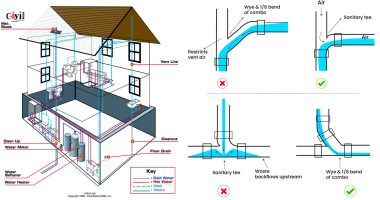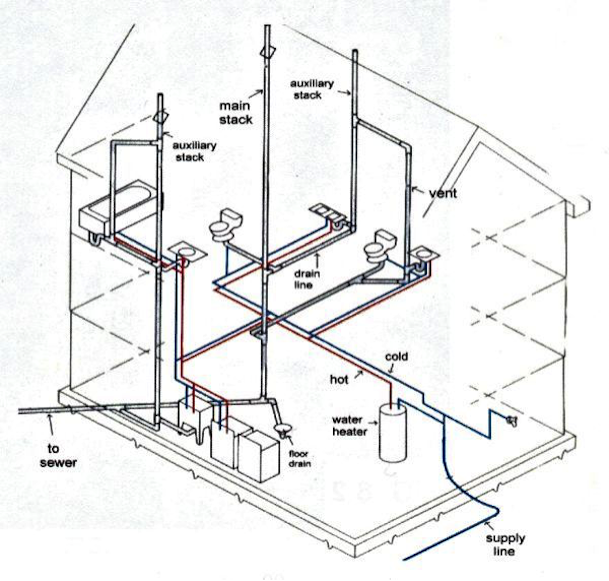A Closer Look at The Layout of Your House's Plumbing System
A Closer Look at The Layout of Your House's Plumbing System
Blog Article
What're your ideas on The Inner Workings of Your Home's Plumbing?

Understanding how your home's pipes system works is necessary for every house owner. From supplying clean water for alcohol consumption, food preparation, and bathing to securely removing wastewater, a well-kept plumbing system is important for your family's health and wellness and convenience. In this extensive overview, we'll explore the elaborate network that composes your home's plumbing and deal tips on upkeep, upgrades, and dealing with usual concerns.
Introduction
Your home's pipes system is more than simply a network of pipelines; it's a complex system that guarantees you have access to clean water and reliable wastewater removal. Understanding its parts and exactly how they interact can help you stop pricey repairs and guarantee every little thing runs efficiently.
Basic Parts of a Plumbing System
Pipelines and Tubes
At the heart of your plumbing system are the pipelines and tubes that carry water throughout your home. These can be made from different products such as copper, PVC, or PEX, each with its advantages in regards to durability and cost-effectiveness.
Fixtures: Sinks, Toilets, Showers, etc.
Components like sinks, commodes, showers, and bathtubs are where water is utilized in your house. Recognizing how these fixtures link to the pipes system aids in diagnosing problems and intending upgrades.
Shutoffs and Shut-off Points
Valves manage the circulation of water in your pipes system. Shut-off valves are essential throughout emergency situations or when you require to make repairs, permitting you to isolate parts of the system without disrupting water flow to the entire house.
Water System System
Key Water Line
The major water line links your home to the local supply of water or a personal well. It's where water enters your home and is dispersed to numerous components.
Water Meter and Stress Regulator
The water meter steps your water usage, while a pressure regulator makes certain that water moves at a risk-free pressure throughout your home's pipes system, stopping damage to pipes and components.
Cold Water vs. Hot Water Lines
Understanding the difference between cold water lines, which provide water straight from the primary, and hot water lines, which carry warmed water from the water heater, helps in fixing and planning for upgrades.
Water drainage System
Drain Pipes Pipes and Traps
Drain pipelines carry wastewater far from sinks, showers, and toilets to the sewer or septic system. Traps avoid sewer gases from entering your home and additionally trap debris that might cause blockages.
Air flow Pipes
Air flow pipes enable air into the drain system, avoiding suction that might slow water drainage and cause catches to empty. Correct ventilation is crucial for preserving the integrity of your plumbing system.
Value of Correct Drain
Guaranteeing appropriate drainage protects against backups and water damages. On a regular basis cleaning drains pipes and keeping traps can avoid expensive repair services and extend the life of your pipes system.
Water Heating System
Kinds Of Hot Water Heater
Water heaters can be tankless or typical tank-style. Tankless heating units warmth water on demand, while containers store warmed water for immediate usage.
How Water Heaters Connect to the Pipes System
Comprehending just how water heaters link to both the cold water supply and warm water distribution lines assists in identifying issues like inadequate warm water or leakages.
Maintenance Tips for Water Heaters
Consistently flushing your hot water heater to remove sediment, inspecting the temperature level settings, and checking for leakages can prolong its lifespan and improve power efficiency.
Common Plumbing Concerns
Leakages and Their Reasons
Leaks can happen as a result of aging pipes, loose installations, or high water stress. Dealing with leakages without delay avoids water damages and mold and mildew growth.
Blockages and Obstructions
Blockages in drains pipes and commodes are frequently brought on by flushing non-flushable items or an accumulation of oil and hair. Making use of drain screens and bearing in mind what goes down your drains can avoid obstructions.
Indications of Pipes Troubles to Expect
Low tide pressure, slow drains, foul odors, or uncommonly high water costs are indications of potential pipes problems that should be dealt with quickly.
Plumbing Upkeep Tips
Routine Assessments and Checks
Set up yearly pipes examinations to capture concerns early. Seek signs of leaks, corrosion, or mineral buildup in faucets and showerheads.
DIY Maintenance Tasks
Simple jobs like cleansing tap aerators, looking for commode leakages making use of color tablet computers, or shielding revealed pipelines in cold environments can protect against major pipes concerns.
When to Call a Specialist Plumbing Professional
Know when a pipes problem needs expert know-how. Trying complicated fixings without appropriate understanding can result in more damages and higher repair service expenses.
Updating Your Pipes System
Factors for Updating
Upgrading to water-efficient fixtures or replacing old pipes can improve water quality, reduce water bills, and increase the value of your home.
Modern Plumbing Technologies and Their Benefits
Discover modern technologies like clever leak detectors, water-saving toilets, and energy-efficient water heaters that can conserve cash and reduce environmental effect.
Expense Considerations and ROI
Calculate the ahead of time expenses versus long-lasting savings when considering pipes upgrades. Numerous upgrades spend for themselves via decreased energy bills and fewer repairs.
Environmental Effect and Preservation
Water-Saving Fixtures and Devices
Mounting low-flow taps, showerheads, and toilets can dramatically minimize water use without giving up performance.
Tips for Lowering Water Usage
Straightforward practices like dealing with leaks immediately, taking much shorter showers, and running full lots of laundry and recipes can preserve water and lower your utility costs.
Eco-Friendly Plumbing Options
Take into consideration sustainable pipes materials like bamboo for flooring, which is durable and eco-friendly, or recycled glass for kitchen counters.
Emergency situation Preparedness
Actions to Take During a Plumbing Emergency situation
Know where your shut-off valves lie and exactly how to turn off the water in case of a burst pipe or significant leakage.
Importance of Having Emergency Calls Convenient
Maintain get in touch with details for local plumbings or emergency situation solutions readily offered for fast reaction throughout a plumbing dilemma.
DIY Emergency Fixes (When Suitable).
Short-term solutions like using air duct tape to patch a dripping pipe or positioning a bucket under a trickling faucet can decrease damage up until a specialist plumbing technician gets here.
Verdict.
Comprehending the makeup of your home's plumbing system equips you to maintain it properly, saving money and time on repairs. By adhering to regular upkeep regimens and staying notified concerning modern pipes technologies, you can ensure your pipes system runs effectively for years to come.
HOW YOUR PLUMBING SYSTEM WORKS
Which Pipes Do What?
Blue lines = fresh water supply entering the building
Red lines = hot water supply entering the building
Grey lines = pipes carrying waste away from the building and venting pipes carrying gases away from the building (through the roof)
YOUR MAIN PLUMBING SYSTEMS
There are two main plumbing systems that support your home s basic plumbing needs one that brings clean water into your home, and one that sends dirty water away from your home. Connected to the toilet, bath, shower, and other faucets in your home, these two systems keep your water flowing in the right directions.
ACCESSING FRESH WATER
Fresh and clean water is brought into your home through the main water supply line . Filtered through one pipe, this water is pressured to flow into the various fixtures in your home at any given time.
This water can be sourced from a well located on your property, a pond or river (mostly cottages), or, as in most cases, from the city s municipal water treatment centre. However, it is important to note that water that is untreated, such as the water siphoned from ponds or rivers, may not be safe to drink. Personal water supplies always need to be treated for hardness and contaminants before consumed.
MUNICIPAL WATER SUPPLIES
Improve taste and odour
Remove sediment
Eliminate hardness
Reduce chlorine
COLD WATER SUPPLY VS. HOT WATER SUPPLY
Cold water flows into your home or building through the service line, which then distributes hot or cold water to your fixtures. This line is most commonly run through a central column that runs floor to floor. Hot water runs in short and straight pipes as the longer the pipeline, the more heat that will be lost in the transfer. Having shorter pipes also allows residents to access hot water more quickly.
WASTE WATER SYSTEM
Your wastewater system is divided into two parts pipes that send wastewater away from your home and venting pipes that send sewer gas away from your home. Sewage water travels through pipes that flush the water and waste towards local sewers that are operated and managed by your city or town. Most sewer systems rely on gravity to move the wastewater to where it needs to go.
The further away from your toilet or sink, the larger wastewater pipes become. This allows for waste to be disposed of from various parts of your home or business at once without pipe blockages. The angle and flow of these pipes are also essential for keeping your waste pipes clear of build up.
https://harrisplumbing.ca/how-your-home-plumbing-system-works/

HOW YOUR PLUMBING SYSTEM WORKS
Which Pipes Do What?
YOUR MAIN PLUMBING SYSTEMS
There are two main plumbing systems that support your home s basic plumbing needs one that brings clean water into your home, and one that sends dirty water away from your home. Connected to the toilet, bath, shower, and other faucets in your home, these two systems keep your water flowing in the right directions.
ACCESSING FRESH WATER
Fresh and clean water is brought into your home through the main water supply line . Filtered through one pipe, this water is pressured to flow into the various fixtures in your home at any given time.
This water can be sourced from a well located on your property, a pond or river (mostly cottages), or, as in most cases, from the city s municipal water treatment centre. However, it is important to note that water that is untreated, such as the water siphoned from ponds or rivers, may not be safe to drink. Personal water supplies always need to be treated for hardness and contaminants before consumed.
MUNICIPAL WATER SUPPLIES
COLD WATER SUPPLY VS. HOT WATER SUPPLY
Cold water flows into your home or building through the service line, which then distributes hot or cold water to your fixtures. This line is most commonly run through a central column that runs floor to floor. Hot water runs in short and straight pipes as the longer the pipeline, the more heat that will be lost in the transfer. Having shorter pipes also allows residents to access hot water more quickly.
WASTE WATER SYSTEM
Your wastewater system is divided into two parts pipes that send wastewater away from your home and venting pipes that send sewer gas away from your home. Sewage water travels through pipes that flush the water and waste towards local sewers that are operated and managed by your city or town. Most sewer systems rely on gravity to move the wastewater to where it needs to go.
The further away from your toilet or sink, the larger wastewater pipes become. This allows for waste to be disposed of from various parts of your home or business at once without pipe blockages. The angle and flow of these pipes are also essential for keeping your waste pipes clear of build up.
https://harrisplumbing.ca/how-your-home-plumbing-system-works/
I was shown that article on Understanding Your Home's Plumbing Anatomy through a good friend on our other web blog. Loved our content? Please quickly share it. Help others find it. Thanks a lot for going through it.
Book Inspection Report this page